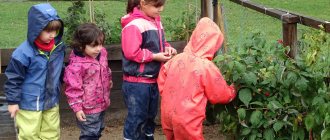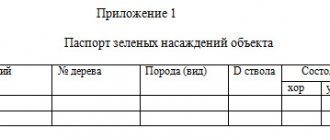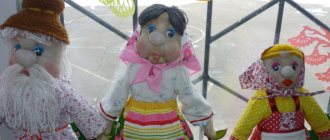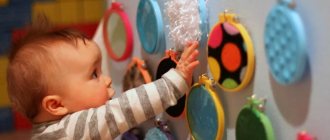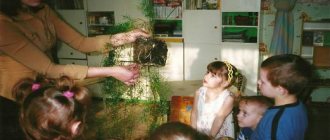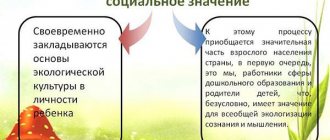Consultation for parents “Environmental education of preschool children.”
Consultation for parents of preschool educational institution “Environmental education of preschool children”
In the modern world, the problem of human interaction with the environment is of particular relevance. Global climate change, a decrease in drinking water supplies, the depletion of natural resources, the threat of extermination of many species of plants and animals and many other environmental problems associated with the consumer attitude of natural resources lead to the problem of human alienation from nature, his low level of formation of an ecological culture. Environmental culture is understood as the inherited and formed experience of human life in its interaction with the natural environment, promoting a healthy lifestyle, sustainable socio-economic development, environmental safety of the country and each person. More and more often we hear and pronounce the word “ecology”. Science is complex, important and necessary. The science is relevant. Environmental education
- a continuous process of education, upbringing and development of a child, aimed at the formation of his ecological culture, which is manifested in an emotionally positive attitude towards nature, the surrounding world, a responsible attitude towards one’s health and the state of the environment, in compliance with certain moral standards, in a system of values orientations.
As practice shows, modern preschoolers have a large amount of knowledge about nature. However, this knowledge is often formed spontaneously, under the influence of television programs, advertising, and cartoons. Only in the process of purposeful work of the kindergarten and parents can an ecological culture, ecological thinking, and environmental consciousness be formed in children. We must instill in children a clear understanding from an early age: man is part of nature.
There will be no greenery, no animals - and he will not live on Earth.
And vice versa: the richer the world around, the better it will be for a person to live in this world. A child’s knowledge of nature affects not only the area of the mind, but also the area of moral feelings. Therefore, while imparting to children knowledge about the animal and plant world, adults at the same time inform them of the rules of behavior in nature. A person who does not see the beauty of nature is worse than a blind person: he has blindness of soul. And from someone whose soul is blind, do not expect kindness or honesty, devotion or courage. Is it necessary to talk about how urgent the issue of instilling in children a caring attitude towards the world around them is? Preschool age
is an important stage in the development of human ecological culture.
During this period, the foundations of personality are laid, including a positive attitude towards nature and the surrounding world. At this age, the child begins to distinguish himself from the environment, an emotional and value-based attitude to the environment develops, and the foundations of the moral and ecological positions of the individual are formed, which are manifested in the child’s interactions with nature, in the awareness of inseparability with it. Thanks to this, it is possible for children to develop environmental knowledge, norms and rules for interacting with nature, develop empathy for it, and be active in solving some environmental problems. At the same time, the accumulation of knowledge in preschool children is not an end in itself. Environmental education of a preschooler
is solved mainly on the basis of the formation of natural history knowledge acquired at the stages of preschool childhood.
Environmental education and upbringing involves the formation in children of knowledge and ideas about the surrounding world, including nature and society; understanding the relationship between these components of the world and interdependence; developing the correct forms of interaction with the environment; development of an emotionally positive attitude towards nature. The formation of the principles of ecological culture
is the formation of a consciously correct attitude directly towards nature itself in all its diversity, towards the people who protect and create it, as well as towards the people who create material or spiritual values based on its wealth.
It is also an attitude towards oneself as a part of nature, an understanding of the value of life and health and their dependence on the state of the environment. This is an awareness of your abilities to interact creatively with nature. The initial elements of ecological culture
are formed on the basis of the interaction of children, under the guidance of adults, with the objective-natural world that surrounds them: plants, animals (communities of living organisms, their habitat, objects made by people from materials of natural origin.
The formation of environmental education of a preschooler involves the solution of the following objectives:
Development in preschool children of environmental ideas, knowledge about the value of nature and the rules of behavior in it. Formation of skills in various activities in nature and the formation of environmentally oriented interaction with its objects. Accumulation of emotionally positive experience by children in communication with nature. Parents must realize that You cannot require a child to follow any rule of behavior if adults themselves do not always follow it. For example, it is difficult to explain to children that they need to take care of nature if parents do not do this themselves. And different requirements imposed in kindergarten and at home can cause they feel confused, resentful, or even aggressive. However, what is possible at home does not necessarily have to be allowed in kindergarten and vice versa. It is necessary to highlight the main things that will require joint efforts from teachers and parents. It is necessary to consider and discuss the results obtained and make a joint decision regarding the final list of vital rules and prohibitions. It is possible to instill in children a positive attitude towards nature only when the parents themselves have an environmental culture. The effect of raising children is largely due to the extent to which environmental values are perceived by adults as vital. A noticeable influence on the upbringing of a child is exerted by the way, level, quality and style of life of the family. Children are very sensitive to what they see around them. They behave like the adults around them. Parents need to realize this.
Only with the help of repeated repetitions of skills, knowledge, and abilities at practical events, it is possible to firmly form an environmental culture in children. In the process of learning to form an ecological culture, the following forms of work can be used: conversations, discussions, social hours, role-playing games. During such events, interaction between adults and children occurs, which provides great opportunities for establishing connections between the conditions of the natural environment and its inhabitants, between animals and plants, between human activities and the state of the natural environment. Among the effective ways of environmental education for children, it is important to note excursions and walks. In order to satisfy the desire to learn as much as possible about the world around them and natural phenomena that attract attention, middle-aged children are actively involved in the observation process. Observation is the main way of forming concrete ideas about nature in preschoolers, the basis of imaginative thinking. Ideas obtained through observation become the meaningful basis for many types of children's activities: play, art, work in nature, communication with it, speech. During your walk, you need to pay attention to the beauty of nature and weather conditions. It is necessary to observe the behavior of animals and the state of plants, teach children to independently notice natural phenomena, name them and draw conclusions, and encourage them to ask questions. Each observation expands and deepens the child’s understanding of the natural environment, gives new knowledge, awakens curiosity and inquisitiveness. Familiarization with specific examples of plants and animals, their mandatory connection with a certain habitat and complete dependence on it allows preschoolers to form initial ideas of an ecological nature. By growing individual specimens of plants and animals, children learn the different nature of their needs for external components of the environment, at different stages of growth and development. An important aspect in this regard is the consideration of human labor as an environment-forming factor. Plant at least one broken one along with the others. A few days later, when you and your child come back to the bed with already strong tomato stems, point to the broken stem and remind him that it was broken when planting. At the same time, do not talk to the child in a didactic tone. Next year the child needs his own garden bed to give him the opportunity to do whatever he wants on it. Under no circumstances should a child be forced or correct what he has done. You can only ask him what he would like.
You can help only by asking his permission and working with him. When you sow cereals, let him throw grains onto the bed with his handle. This way the child will show interest in the plant world. The point is not only that he will know and feel how and what is growing. The main thing is that he will start thinking and analyzing. Introduce your child to various birds, their habits, show photographs, most likely he will be incredibly happy and receive a lot of positive emotions from the fact that each bird has its own unique trill song (excluding, of course, the species - the mockingbird and its genus, which are able to repeat songs many birds, indistinguishable from the original). You can listen to several types of songs of the most common birds. It will be easier for you to start with them. Of course, bright pictures and sounds of bird trills will interest your baby, and the ecological game will turn into an exciting lesson from which your baby will not only want to learn a lot about birds, he will learn a lot - including learning a lot of terms and learning how to correctly analyze living nature. It is also important that a corner of nature is present in the child’s home and is always at hand. Collecting herbariums, cones, beautiful pebbles and even bird feathers is all a way of understanding the world around us. Well, keeping pets and caring for them is also a big contribution to the environmental development of a child, the education of moral and ethical qualities; you should not deprive him of such interaction with nature.
We play
with the children
“What would happen if they disappeared from the forest...”
We suggest removing insects from the forest.
What would happen to the rest of the inhabitants? What if the birds disappeared? What if the berries disappeared? What if there were no mushrooms? What if the hares left the forest? It turns out that it was no coincidence that the forest gathered its inhabitants together. All forest plants and animals are connected to each other. They won't be able to do without each other. “Which plant is gone?”
Four or five plants are placed on a table.
The child remembers them. We invite the children to close their eyes and remove one of the plants. Children open their eyes and remember which plant was still standing. The game is played 4-5 times. You can increase the number of plants on the table each time. “Where does it ripen?”
Goal: learn to use knowledge about plants, compare the fruits of a tree with its leaves.
Progress of the game: we lay out two branches on the table: on one - the fruits and leaves of one plant (apple tree, on the other - the fruits and leaves of different plants. (for example, gooseberry leaves, and pear fruits) We ask the question: “Which fruits will ripen and which will not "The child corrects mistakes made in drawing up the drawing. "Flower Shop"
You can play with the child in the shop. Purpose: to consolidate the ability to distinguish colors, name them quickly, find the right flower among others. Teach to group plants by color, make beautiful bouquets. Progress games: A child comes to a store where a large selection of flowers is presented. Option 1. On the table is a tray with multi-colored petals of different shapes. Selects the petals he likes, names their color, and find a flower that matches the selected petals in both color and shape. Option 2. The child independently makes three bouquets of flowers: spring, summer, autumn.You can use poems about flowers.
Fairy tale game “Fruits and vegetables”
Visual material:
pictures of vegetables.
A parent says:
“One day a tomato decided to gather an army of vegetables.”
They came to her with peas, cabbage, cucumber, carrots, beets, onions, potatoes, turnips (she puts pictures of these vegetables on the stand one by one) And the tomato said to them: “There are a lot of people who want it, it turns out, so I set this condition: first of all, to join the army.” My only vegetables will be those whose names contain the same sounds as in my poommiidoorr.” - What vegetables do you think responded to his call? The child names, highlighting the necessary sounds with his voice: gorrooh, morrkoo, karrttoofel, turnip, cucumber, and explains that these words have the sounds p, p, as in the word tomato. Pictures depicting the named vegetables move closer to the tomato. Tomato conducts various training sessions with peas, carrots, potatoes, and turnips. Good for them! And the rest of the vegetables were saddened: the sounds that make up their names in no way fit the sounds of the tomato, and they decided to ask the tomato to change the condition. Tomato agreed: “Have it your way!” Come now, those whose names have as many parts as mine.” - Who do you think responded now? Together we find out how many parts there are in the word tomato and in the name of the remaining vegetables. The answer explains in detail that the words tomato and, for example, cabbage have the same number of syllables. Pictures depicting these plants also move towards the tomato. “But the onions and beets were even more saddened. How do you think why? explains that the number of parts in the name is not the same as that of a tomato, and the sounds do not match. Distribution of fruits by color
We invite the child to distribute the fruits by color: put fruits with a red tint on one dish, yellow ones on another, and green ones on a third.
The game character (for example, Winnie the Pooh) also participates in this and makes mistakes: for example, he puts a yellow pear with green fruits. The child kindly and delicately points out the teddy bear’s mistake, names shades of color: light green (cabbage, bright red (tomato), etc. Distribution of fruits according to shape and taste
An adult invites children to arrange the fruits differently, according to shape: round - one dish, oblong ones - on another. After clarification, he gives the children the third task: distribute the fruits according to taste - put sweet fruits on one dish, savory ones on the other. Piglet rejoices - he loves everything sweet. When the distribution is over, he puts the dish with sweet fruits to to myself: “I really love honey and everything sweet!” “Piglet, is it really good to take all the delicious things for yourself?” says the teacher. “Children also love sweet fruits and vegetables. Go wash your hands, and I’ll cut the fruits and vegetables and treat everyone "
"The Fourth Wheel"
You already know that not only insects and birds fly, but there are also flying animals. To make sure that you are not confusing insects with other animals, we will play the game "The Fourth Wheel" hare, hedgehog, fox , bumblebee; wagtail, spider, starling, magpie; butterfly, dragonfly, raccoon, bee; grasshopper, ladybug, sparrow, chafer; bee, dragonfly, raccoon, bee; grasshopper, ladybug, sparrow, mosquito; cockroach, fly, bee, cockchafer; dragonfly, grasshopper, bee, ladybug; frog, mosquito, beetle, butterfly; dragonfly, moth, bumblebee, sparrow. In order for a child to fall in love with nature, begin to respect it and treat it with care, not much is needed, because he is a part of it himself. Everything necessary is already inherent in the child from the very beginning. The child’s need to communicate with living nature will help to show sensitivity and kindness in him. And the aesthetic sense of beauty and understanding of nature will force him to take the initiative that is so necessary in our time in preserving our beautiful and vulnerable surrounding world.
MAGAZINE Preschooler.RF
Consultation for educators: “The role of the educator in the environmental education of a preschool child.”Teacher Esina Marina Aleksandrovna
MBDOU kindergarten "Belochka" Tambov, Tambov region.
When a child communicates with nature, a contradiction often arises. On the one hand, they are very interested in plants and animals, they love them, on the other hand, they show cruelty and indifference. Thus, children tear off the wings of insects and tear apart earthworms. Because of a momentary whim, children break branches of trees and bushes, tear them in armfuls and then, without regret, throw away flowering plants and trample lawns. At the same time, children do not regard their actions as a manifestation of evil.
Why is this happening? This is due, first of all, to preschoolers’ ignorance of the rules of interaction with natural objects.
On their own, it is difficult for preschoolers to see, for example, the manifestation of plant life, to understand that they, like other living beings, breathe, eat, move, and reproduce.
Therefore, adults come to the child’s aid, and in kindergarten, of course, a teacher who will help the child understand all the diversity of the world around him.
I would like to share the experience of my work in this direction, namely, what I did so that interaction with nature contributed to the formation of a friendly and correct attitude towards it in a preschooler.
Firstly, she tried to be a bearer of ecological culture and, through her behavior and actions, created a model of interaction with nature, a caring attitude towards it, and demonstrated the necessity and significance of everything that happens in front of children.
Secondly, she taught children to empathize and instilled in them an emotionally positive attitude towards nature. After all, emotions play a big role in the perception of nature, its beauty and uniqueness, as well as in showing sympathy for those who are in trouble, and a child is, as it were, “charged” with our emotions. Therefore, every time, at any opportunity, I admired natural objects and phenomena, found even the most unsightly, at first glance, object of nature and admired it. For example: I was surprised at the blue sky, white clouds and bright stars, a beautiful moth and a long worm, grass breaking through the asphalt, etc. She admired the good deeds of people, felt joy from the well-being of a living being and tried to “infect” children with this. Whenever possible, she always inserted a poetic word, and a poetic word will always leave an indelible mark in the heart of a child.
Thirdly, in no case should it be allowed that a child’s interaction with nature has a negative connotation.
And if an adult does not pay attention to this, children get used to dividing natural objects into beautiful and ugly, necessary and unnecessary, and build their attitude towards them accordingly. As a result, instead of accumulating positive emotions - surprise (for example, how interestingly a grasshopper has adapted to its environment), empathy (for example, a bug in trouble) - the child gains the experience of an indifferent or even heartless attitude towards objects that, in his opinion, are unpleasant.
The next point is introducing children to work.
Work activity must be regular. It is important for the teacher to introduce every child to it, since work in a corner of nature or in a kindergarten area contributes to the development of children’s powers of observation and curiosity, inquisitiveness, and arouses their interest in objects of nature and human labor.
In the process of working in nature, children develop knowledge about plants and animals (appearance, needs, methods of movement, habits, lifestyle, seasonal changes). Children learn to make connections between conditions, the way of life of an animal in nature and ways to care for it in a corner of nature.
When implementing environmental education, I tried to follow an integrated approach, which involves the interconnection of research activities, modeling, music, visual arts, physical education, games, theatrical activities, etc. It is this approach, in my opinion, that greens various types of child activities.
Working with parents.
A noticeable influence on the upbringing of a child is exerted by the way, level, quality and style of life of the family. Children are very sensitive to what they see around them. They behave like the adults around them.
Parents must realize that they cannot demand that their child follow any rule of behavior if adults themselves do not always follow it. For example, it is difficult to explain to children that they need to protect nature if the parents do not do this themselves. And the different demands made in kindergarten and at home can cause them confusion, resentment, or even aggression.
I work with parents in the form of meetings (general and group) in order to inform parents about joint work and stimulate their active participation in it. I invite them to classes, post a lot of visual material, and publish booklets on the topic of taking care of and protecting nature.
Now let's consider the question: how should this activity be organized in different age groups in order to realize its leading motive - the education of preschoolers in the principles of environmental culture - and achieve specific goals?
At early preschool age, children in joint activities are more observers than practical performers, and yet it is at this age that the pattern of interaction with nature is decisive: children hear and absorb the gentle conversation of an adult with animals and plants, calm and clear explanations about , what and how to do, they see the actions of the teacher and willingly take part in them. For example, having invited children to participate in watering indoor plants, the teacher says something like this: “Let's go to the window, look at our plants, talk to them and water them. (We went to the window.) Hello, flowers! How are you feeling? Are they not frozen or dry? (Examines the plants.) No, everything is fine - you are green and beautiful. Look how good our plants are, how nice it is to look at them! (Touches the soil in the pot.) Dry soil, but plants need water - they are alive, they cannot live without water! . " The teacher gives each child a watering can with a little water in it, waters everything himself, saying: “Ogonyok, we will pour a lot of water into your pot, drink as much as you want and continue to grow - we will admire you!” Children's participation in this joint activity consists of listening to the teacher's speech, observing his actions, holding watering cans, giving and receiving them, together filling them with water and putting them in place. The teacher takes care of the plants in front of the children and together with them - this is an example of interaction with nature. Learning as a didactic task is not in the foreground; it occurs by itself, naturally in the process of joint practical activity.
In the middle group, the teacher and children act together, although priority belongs to the adult, which is expressed in the formula: “I do - you help me, you are my assistants. We take care of our pets together!”
In older preschool age, children's independence rapidly increases, and it becomes possible for them to be on duty in a corner of nature. The adult and children change roles: the children do everything necessary themselves, and the teacher helps them (it doesn’t matter that the help at first can be very large). The teacher makes sure to note all the children’s achievements and praise them for their independence, confidence and initiative. Teachers who do everything themselves and do not give preschoolers the opportunity to observe and participate in creating normal conditions for the inhabitants of living corners, nature rooms, plots, develop in children indifference, callousness and inattention in general to life as a unique value.
These, in my opinion, are the basic conditions that are necessary for the environmental education of children.
| Next > |

